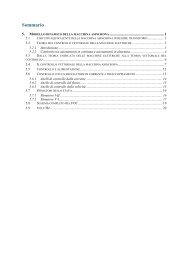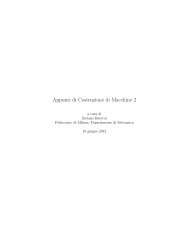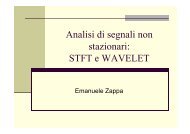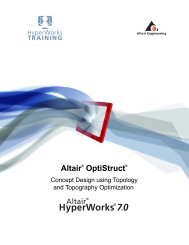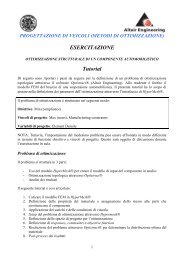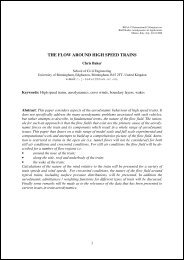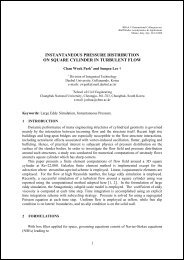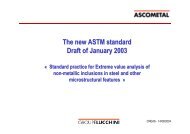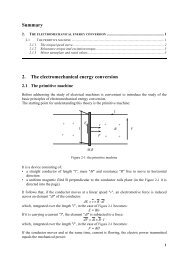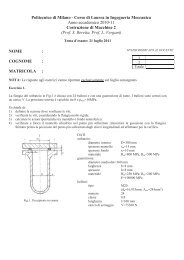spectral les of turbulent flows over bluff bodies: from the ... - BBAA VI
spectral les of turbulent flows over bluff bodies: from the ... - BBAA VI
spectral les of turbulent flows over bluff bodies: from the ... - BBAA VI
You also want an ePaper? Increase the reach of your titles
YUMPU automatically turns print PDFs into web optimized ePapers that Google loves.
Minguez Matthieu, Pasquetti Richard and Serre Ericclassical experimental and LES works [13, 20]. The influence <strong>of</strong> <strong>the</strong> near wall correction, detailedin Minguez et al. [16], is quantified through <strong>the</strong> <strong>turbulent</strong> boundary layer characteristicsas well as <strong>the</strong> aerodynamics properties <strong>of</strong> <strong>the</strong> flow. Finally, <strong>the</strong> study is extended to <strong>the</strong> morecomplex configuration <strong>of</strong> <strong>the</strong> flow around <strong>the</strong> car model.2 NUMERICAL MODEL2.1 SPACE AND TIME APPROXIMATIONSThe numerical method is based on a multi-domain Chebyshev-Fourier approximation. In<strong>the</strong> streamwise x-direction, <strong>the</strong> computational domain is decomposed in non <strong>over</strong>lapping subdomains<strong>of</strong> different lengths, depending on <strong>the</strong> flow region. The continuity <strong>of</strong> <strong>the</strong> solution at<strong>the</strong> sub-domain interfaces is ensured by using an influence matrix technique, as in Sabbah andPasquetti [22]. In each sub-domain, a collocation Chebyshev method is used in <strong>the</strong> y-verticaland streamwise directions, whereas a Fourier-Galerkin method is used in <strong>the</strong> z-spanwise periodicdirection. In order to refine <strong>the</strong> Gauss-Lobatto-Chebyshev (GLC) mesh around <strong>the</strong> <strong>bluff</strong>body, we use a mapping to accumulate grid-points at <strong>the</strong> <strong>bluff</strong> body, especially in y-direction.The discretization in time is based on a fractional step method. Globally 2 nd order accurate, itmakes use <strong>of</strong> <strong>the</strong> following three steps, as detailed in Cousin and Pasquetti [4]:- An explicit transport step, based on an Operator Integration Factor (OIF) semi Lagrangianmethod and a 4 th order Runge-Kutta scheme to handle <strong>the</strong> non-linear convective term.- An implicit diffusion step, to handle <strong>the</strong> linear viscous term. Time derivatives <strong>of</strong> <strong>the</strong> velocitycomponents are approximated at <strong>the</strong> resolution time t n+1 with second order backwarddifferences and <strong>the</strong> pressure is expressed at time t n , using <strong>the</strong> so-called Goda scheme, toobtain a provisional velocity.- A projection step, to obtain a divergence free velocity field. It is based on an unique grid“P N −P N−2 ” approximation, so that no boundary conditions are required for <strong>the</strong> pressure.It is indeed a Darcy type problem, ra<strong>the</strong>r than a Poisson one, which is solved at this step.In our implementation, <strong>the</strong> P N − P N−2 approximation, where <strong>the</strong> polynomial degree for<strong>the</strong> pressure is two degrees <strong>les</strong>s than for <strong>the</strong> velocity components, has been extended to <strong>the</strong>case <strong>of</strong> our multi-domain approximation: Unknown values <strong>of</strong> <strong>the</strong> pressure are consideredat all <strong>the</strong> inner grid-points, including <strong>the</strong> sub-domain interface points.2.2 SPECTRAL VANISHING <strong>VI</strong>SCOSITY BASED LESFirst introduced by Tadmor [24] to solve non-linear hyperbolic equations, typically <strong>the</strong> Burgersequation, using standard Fourier <strong>spectral</strong> methods, <strong>the</strong> SVV method for <strong>the</strong> LES (SVV-LES)<strong>of</strong> incompressible <strong>turbulent</strong> <strong>flows</strong> has already shown its effectiveness through different works,see e.g. Karamanos and Karniadakis [9], Kirby and Karniadakis [10], Pasquetti [18] and morerecently Severac et al. [23] and Minguez et al. [16].The SVV stabilization is introduced in <strong>the</strong> Navier-Stokes equations through a SVV modifiedviscous term ∆ SV V , so that <strong>the</strong> numerical approximation <strong>of</strong> <strong>the</strong> velocity and pressure fields,say (u N , p N−2 ), solves (in <strong>the</strong> collocation Chebyshev-Galerkin Fourier sense) <strong>the</strong> semi-discrete3
Minguez Matthieu, Pasquetti Richard and Serre Ericwhere C is a penalization constant and χ(x) <strong>the</strong> characteristic function <strong>of</strong> <strong>the</strong> obstacle, equalto 1 inside <strong>the</strong> <strong>bluff</strong> body and 0 elsewhere. A modified penalization method, named pseudopenalization(see Pasquetti et al. [18]) because <strong>the</strong> penalization is implicitly involved within <strong>the</strong>time scheme, is in fact applied here to improve <strong>the</strong> numerical stability.Commonly, for this kind <strong>of</strong> modelization and more particularly when <strong>spectral</strong> methods areconcerned, one has to smooth <strong>the</strong> characteristic function in order to avoid Gibbs phenomena.However, despite <strong>the</strong> fact such a smoothing is carefully discussed in [18], as detailed in <strong>the</strong>present paper our best SVV-LES results have been obtained without smoothing. Tests haveequally shown that no Gibbs phenomena occurred, certainly due to <strong>the</strong> SVV high frequencydissipation term.2.4 NEAR WALL TREATMENTIn parallel to <strong>the</strong> near wall treatments [19] developed for finite volume approximations andso inapplicable in our SVV-LES methodology, we make use <strong>of</strong> an original SVV near wallcorrection, as presented in Minguez et al. [16]. In order to capture at <strong>the</strong> best <strong>the</strong> turbulenceproduction phenomena localized in <strong>the</strong> near-wall region, keeping <strong>the</strong> global stability <strong>of</strong> <strong>the</strong>solution, we simply relax <strong>the</strong> SVV stabilization within <strong>the</strong> boundary layers by increasing <strong>the</strong>activation parameter m N . Consequently, one diminishes <strong>the</strong> range <strong>of</strong> frequencies on which <strong>the</strong>SVV acts. This near-wall correction is introduced with a new characteristic function χ BL (x),equal to 1 in <strong>the</strong> near wall (NW) region and to 0 outside. The stabilized Navier-Stokes equationsare <strong>the</strong>n reformulated as :∂ t u N + u N · ∇u N = −∇p N−2 + ν∆ SV V u N − Cχu N + f BL (8)with BL for Boundary Layer and where :f BL = χ BL ν(∆ BLSV V u N − ∆ SV V u N ) . (9)The operator ∆ BLSV V is defined like ∆ SV V but makes use <strong>of</strong> a greater value <strong>of</strong> m N . Note thata smaller value <strong>of</strong> ɛ N is also possible to modify <strong>the</strong> influence <strong>of</strong> <strong>the</strong> SVV terms, but wouldbe more drastic. More<strong>over</strong>, in order to take into account <strong>the</strong> strong anisotropy <strong>of</strong> <strong>the</strong> flowin this region and <strong>the</strong> distribution <strong>of</strong> grid-points in <strong>the</strong> three directions, <strong>the</strong> operator ∆ BLSV V isanisotropic. Thus, <strong>the</strong> values <strong>of</strong> <strong>the</strong> parameter m N differ, depending on <strong>the</strong> direction (x, y, z).In practice, its values are increased till preserving <strong>the</strong> numerical stability <strong>of</strong> <strong>the</strong> computation.3 SQUARE CYLINDER TURBULENT FLOWThe flow <strong>over</strong> <strong>the</strong> square cylinder is very well documented and so allows <strong>the</strong> validation <strong>of</strong>LES <strong>of</strong> separated <strong>turbulent</strong> <strong>flows</strong>. The ability <strong>of</strong> our SVV-LES approach to predict such acomplex flow is shown by comparing our results to former ones, obtained both by LES [20]and experimental measurements [13]. We especially point out <strong>the</strong> efficiency <strong>of</strong> <strong>the</strong> near walltreatment previously described. To this end, we compare results obtained with <strong>the</strong> standardSVV-LES methodology, i.e., with a smoothing <strong>of</strong> <strong>the</strong> <strong>bluff</strong> body characteristic function andwithout near wall treatment, and <strong>the</strong> hereafter so-called SVV-NW methodology, i.e., withoutsmoothing and with near wall treatment (SVV-LES + NW).5
Minguez Matthieu, Pasquetti Richard and Serre Eric3.2.1 Mean velocity and stress tensor components pr<strong>of</strong>i<strong>les</strong>The mean pr<strong>of</strong>i<strong>les</strong> <strong>of</strong> <strong>the</strong> streamwise velocity and components <strong>of</strong> <strong>the</strong> stress tensor have beenaveraged both in time and in <strong>the</strong> z-spanwise homogeneous direction. Results obtained with <strong>the</strong>standard SVV-LES and <strong>the</strong> SVV-NW approaches are plotted in Figure 2 and 3, toge<strong>the</strong>r withthose <strong>of</strong> <strong>the</strong> experimental and numerical reference studies [13, 20].21.81.6Exp LynLES Rodi UK2SVV−LES with smoothingSVV−LES + NW21.81.6Exp LynLES Rodi UK2SVV−LES with smoothingSVV−LES + NW1.41.4y1.2y1.2110.80.80.60.6a0.4−0.4 −0.2 0 0.2 0.4 0.6 0.8 1 1.2 1.4 1.6Ub0.4−0.4 −0.2 0 0.2 0.4 0.6 0.8 1 1.2 1.4 1.6U21.81.6Exp LynLES Rodi UK2SVV−LES with smoothingSVV−LES + NW21.81.6Exp LynLES Rodi UK2SVV−LES with smoothingSVV−LES + NW1.41.4y1.2y1.2110.80.80.60.6c0.4−0.4 −0.2 0 0.2 0.4 0.6 0.8 1 1.2 1.4 1.6Ud0.4−0.2 0 0.2 0.4 0.6 0.8 1 1.2 1.4 1.6UFigure 2: y-pr<strong>of</strong>i<strong>les</strong> <strong>of</strong> <strong>the</strong> mean streamwise velocity U =< u x > in <strong>the</strong> boundary layer <strong>of</strong> <strong>the</strong> square cylinder atx = −0.375D (a), x = −0.125D (b), x = 0.25D (c) and x = 0.5D(d), obtained with <strong>the</strong> standard and improvedSVV-LES approaches. Comparisons with <strong>the</strong> LES <strong>of</strong> Rodi et al. [20]) and with <strong>the</strong> experiments <strong>of</strong> Lyn [13].Present results are globally in good agreement with <strong>the</strong> experimental data despite <strong>of</strong> a coarserresolution than in Rodi et al. [20]. The NW treatment considerably improves <strong>the</strong> present LESresults.In near-wall region, <strong>the</strong> SVV-NW simulations give a satisfactory estimation <strong>of</strong> <strong>the</strong> extremum<strong>of</strong> <strong>the</strong> mean streamwise velocity U as well as its location, within <strong>the</strong> boundary layer, see Figure2. The results are even better than those provided, 15 years ago, by Rodi et al. [20] whichtend to <strong>over</strong>estimate <strong>the</strong> maximum <strong>of</strong> U. The recirculation zone on <strong>the</strong> cylinder is particularlywell described, with a maximal relative error <strong>of</strong> about 10% with respect to <strong>the</strong> first experimentalmeasurement point <strong>from</strong> <strong>the</strong> wall in Figure 2b). Within <strong>the</strong> shear layer generated by <strong>the</strong> juxtaposition<strong>of</strong> <strong>the</strong> recirculation zone and <strong>the</strong> external velocity field (at y ≃ 0.8), all <strong>the</strong> LES results<strong>over</strong>estimate <strong>the</strong> streamwise velocity in an intermediate region <strong>of</strong> height ∆y ≃ 0.5. This ten-7
Minguez Matthieu, Pasquetti Richard and Serre Eric21.8Exp LynLES Rodi UK2SVV−LES with smoothingSVV−LES + NW21.8Exp LynLES Rodi UK2SVV−LES with smoothingSVV−LES + NW1.61.61.41.4y1.2y1.2110.80.80.60.6a0.40 0.02 0.04 0.06 0.08 0.1 0.12 0.14< u’ 2 >b0.40 0.05 0.1 0.15 0.2 0.25 0.3 0.35 0.4 0.45< u’ 2 >21.8Exp LynLES Rodi UK2SVV−LES with smoothingSVV−LES + NW21.8Exp LynLES Rodi UK2SVV−LES with smoothingSVV−LES + NW1.61.61.41.4y1.2y1.2110.80.80.60.6c0.40 0.1 0.2 0.3 0.4 0.5 0.6 0.7< u’ 2 >d0.40 0.1 0.2 0.3 0.4 0.5 0.6 0.7< u’ 2 >Figure 3: y-pr<strong>of</strong>i<strong>les</strong> <strong>of</strong> <strong>the</strong> streamwise stress term < u ′2 > in <strong>the</strong> boundary layer <strong>of</strong> <strong>the</strong> square cylinder at x =−0.375D (a), x = −0.125D (b), x = 0.25D (c) and x = 0.5D (d), obtained with <strong>the</strong> standard and improvedSVV-LES approaches. Comparisons with <strong>the</strong> LES <strong>of</strong> Rodi et al. [20]) and with <strong>the</strong> experiments <strong>of</strong> Lyn [13].dency seems even enforced for <strong>the</strong> SVV-NW results, although <strong>the</strong> NW treatment is not activein this flow region. However, <strong>the</strong> difference becomes weaker when x increases.As expected, <strong>the</strong> agreement on <strong>the</strong> streamwise stress tensor term < u ′2 >, see Figure 3, isnot so good. At <strong>the</strong> different locations in <strong>the</strong> x-streamwise direction, all <strong>the</strong> LES results <strong>over</strong>estimate<strong>the</strong> maximum values even if <strong>the</strong>ir locations are well predicted, within <strong>the</strong> shear layer atabout y ≃ 0.8. Never<strong>the</strong><strong>les</strong>s, SVV-NW results are closer to <strong>the</strong> experiments <strong>of</strong> reference [13]and so provide a realistic level <strong>of</strong> turbulence.In order to estimate <strong>the</strong> impact <strong>of</strong> <strong>the</strong> SVV-NW on <strong>the</strong> local turbulence level, a comparison <strong>of</strong><strong>the</strong> <strong>turbulent</strong> local Reynolds number is presented in Figure 4 between SVV-LES and SVV-NWresults. The local Reynolds number is defined as Re = u τ ∆y p /ν, with ∆y p <strong>the</strong> distance <strong>of</strong> <strong>the</strong>first mesh point <strong>from</strong> <strong>the</strong> wall, and u τ <strong>the</strong> friction velocity estimated <strong>from</strong> <strong>the</strong> simplified onedimensional integrated boundary layer equation [25],ν dUdy − < u′ v ′ >≃ u 2 τ (10)The results show that <strong>the</strong> viscous contribution νdU/dy remains globally equal in a) and b) while,as expected, <strong>the</strong> <strong>turbulent</strong> contribution − < u ′ v ′ > is largely increased with <strong>the</strong> SVV-NW simulations.The stability constraints and turbulence considerations on which <strong>the</strong> NW treatment8
Minguez Matthieu, Pasquetti Richard and Serre Eric2520h.(nu d yU) 1/2 / nuh.(−< u’v’ >) 1/2 / nuh.(nu d yU − < u’v’ >) 1/2 / nu6050h.(nu d yU) 1/2 / nuh.(− < u’v’ >) 1/2 / nuh.(nu d yU − < u’v’ >) 1/2 / nu4015Re turbRe turb301020510a0−0.5 −0.4 −0.3 −0.2 −0.1 0 0.1 0.2 0.3 0.4 0.5xb0−0.5 −0.4 −0.3 −0.2 −0.1 0 0.1 0.2 0.3 0.4 0.5Figure 4: Contribution <strong>of</strong> <strong>the</strong> different terms <strong>of</strong> <strong>the</strong> boundary layer equation (10) computed <strong>from</strong> SVV-LES withsmoothing <strong>of</strong> <strong>the</strong> characteristic function and without SVV-NW (a) and without smoothing <strong>of</strong> <strong>the</strong> characteristicfunction but with SVV-NW (b); in legend nu ≡ ν, h ≡ ∆y p and Re turb ≡ Re τ .xwas built are thus verified. Consequently, it appears that although <strong>the</strong> boundary layer is notcompletely resolved by <strong>the</strong> mesh, <strong>the</strong> SVV-NW approach provides a good estimation <strong>of</strong> <strong>the</strong><strong>turbulent</strong> production.3.2.2 Mean aerodynamic coefficientThe mean drag coefficient, < C d >, and its rms fluctuations, C drms , have been computed.They are compared with reference values in Table 1.Table 1: Aerodynamic features.< C d > C drms < C dp > StExp[13] 1.9 − 2.2 0.1 − 0.2 0.132LES[20] 2.2 0.14 0.138SV V − LES 2.31 0.131 2.26 0.141SV V − LES + NW 2.18 0.116 2.17 0.141SVV-NW provides a good estimation <strong>of</strong> <strong>the</strong> drag coefficient < C d >. Without NW treatment,<strong>the</strong> agreement is not so good and <strong>the</strong> drag coefficient is <strong>over</strong>estimated. In order to understandwhy <strong>the</strong> drag coefficient is larger without NW treatment, we have computed <strong>the</strong> pressure contributionsto <strong>the</strong> total drag, see column < C dp > in Table 1. The delay <strong>of</strong> <strong>the</strong> detachment on<strong>the</strong> wall <strong>of</strong> <strong>the</strong> cylinder (cf subsection 3.2.1, Figure 2), shifts downstream <strong>the</strong> recirculation zonealong <strong>the</strong> cylinder and behind in <strong>the</strong> near wake. Consequently, <strong>the</strong> pressure repartition and <strong>the</strong>total drag are modified.As in <strong>the</strong> former LES results <strong>of</strong> Rodi et al. [20], <strong>the</strong> present SVV-LES <strong>over</strong>estimate <strong>the</strong> Strouhalnumber (+7%) with respect to <strong>the</strong> experiments.9
Minguez Matthieu, Pasquetti Richard and Serre Eric4 AHMED BODY TURBULENT FLOWThe SVV-LES methodology has also been applied to a much more challenging benchmark:<strong>the</strong> flow <strong>over</strong> a simplified car model, <strong>the</strong> “Ahmed body”, at Reynolds number Re = 768000.The SVV-LES results have been compared to <strong>the</strong> experiments <strong>of</strong> Lienhart et al. [12] and to <strong>the</strong>numerical ones <strong>of</strong> Guilmineau [7] and Hinterberger et al. [8], using RANS or LES approaches,respectively.4.1 TEST CASE DESCRIPTION AND NUMERICAL DETAILSThe geometry was proposed in <strong>the</strong> ERCOFTAC benchmark [15] and corresponds to a slantincidence angle <strong>of</strong> 25 o . The dimensions and <strong>the</strong> shape <strong>of</strong> <strong>the</strong> car model are <strong>the</strong> ones <strong>of</strong> Lienhartet al. [12], see figure 5. The <strong>bluff</strong> body, <strong>of</strong> length L = 1044 mm, height h = 288 mm and widthw = 389 mm, is positioned at d = 50 mm <strong>from</strong> <strong>the</strong> ground. The (x,y,z) directions correspondto <strong>the</strong> streamwise, vertical and spanwise directions, respectively. The channel is <strong>of</strong> rectangularsection, 1370 mm × 1000 mm, in <strong>the</strong> (x,y) directions, and spreads on 4 lengths L <strong>of</strong> <strong>the</strong> <strong>bluff</strong>body, which is located at <strong>the</strong> distance L <strong>from</strong> <strong>the</strong> inlet.The computational domain is decomposed in eight sub-domains in <strong>the</strong> x-streamwise direction.Figure 5: Geometry <strong>of</strong> <strong>the</strong> Ahmed body.Three are devoted to <strong>the</strong> Ahmed body and one entirely for <strong>the</strong> slant part. Each sub-domain isdiscretized using N x = 40, N y = 190 and N z = 340, so that one has about 21.10 6 mesh points.Despite using a mapping in <strong>the</strong> y-vertical direction to accumulate grid points on <strong>the</strong> upper panel,<strong>the</strong> first grid point is located at ∆y + = 350 <strong>from</strong> <strong>the</strong> body ro<strong>of</strong>.At <strong>the</strong> inlet, a bulk velocity U e = 40m/s is imposed and a stiff variation is used to match <strong>the</strong>no-slip condition at <strong>the</strong> ground. The Reynolds number, Re=768000, is based on this velocityand on <strong>the</strong> height <strong>of</strong> <strong>the</strong> car h.The SVV parameters have been chosen anisotropic as (m Nx , m Ny , m Nz ) = (2 √ N x , 5 √ √N y , 4 N z /2)and ɛ N = 1/N in <strong>the</strong> boundary layers whereas in <strong>the</strong> complete domain (m N , ɛ N ) = ( √ N, 1/N).The simulations have been performed on <strong>the</strong> NEC-SX8 and have been required 18 GB <strong>of</strong> memoryand 500 CPU hours to get convergence.It would be noticed that <strong>the</strong> present SVV-LES results have been obtained with <strong>the</strong> NW treatmentpreviously justified for <strong>the</strong> square cylinder wake flow.10
Minguez Matthieu, Pasquetti Richard and Serre Eric4.2 TURBULENCE STATISTICSThe statistics have been converged <strong>over</strong> <strong>the</strong> 40 time units, h/U e , corresponding to about0.29 s (physical time).4.2.1 Mean flow and stress tensor components pr<strong>of</strong>i<strong>les</strong>The topology <strong>of</strong> <strong>the</strong> mean flow, fully discussed in Minguez et al.[16], is visualized in Figure6 by <strong>the</strong> three-dimensional streamlines. As expected <strong>from</strong> <strong>the</strong> experiments <strong>of</strong> Ahmed et al. [1],two strong contra-rotative trailing vortices coming <strong>from</strong> <strong>the</strong> slant side edge develop and spreadfar<strong>the</strong>r in <strong>the</strong> wake. More<strong>over</strong>, a partial recirculation bubble, between <strong>the</strong> streamwise vorticalstructures, is confined on <strong>the</strong> upper half part <strong>of</strong> <strong>the</strong> slant. Downstream <strong>the</strong> recirculation zonebehind <strong>the</strong> <strong>bluff</strong> body, two large contra-rotative vortices develop in <strong>the</strong> near wake.Figure 6: Mean three-dimensional streamlines colored by <strong>the</strong> mean streamwise velocity, view <strong>from</strong> behind.The pr<strong>of</strong>i<strong>les</strong> <strong>of</strong> <strong>the</strong> mean streamwise velocity in <strong>the</strong> symmetry plane (see Figure 7a) showa ra<strong>the</strong>r satisfactory agreement with <strong>the</strong> experiments. The main experimental characteristicsare rec<strong>over</strong>ed, despite a too thick boundary layer arriving on <strong>the</strong> slant. At <strong>the</strong> beginning <strong>of</strong> <strong>the</strong>slant <strong>the</strong> fluid detaches and reattaches far<strong>the</strong>r on <strong>the</strong> middle part <strong>of</strong> <strong>the</strong> panel. Consequently, <strong>the</strong>boundary layer thickness increases along <strong>the</strong> slant which is in good agreement with <strong>the</strong> experiments.Classical RANS approaches [7] fail to predict this behavior : <strong>the</strong> flow does not separate<strong>over</strong> <strong>the</strong> slant so that all <strong>the</strong> main characteristics <strong>of</strong> <strong>the</strong> boundary layer get lost, see Figure 7a.In <strong>the</strong> near wake, <strong>the</strong> numerical results match relatively well <strong>the</strong> experimental pr<strong>of</strong>i<strong>les</strong> whilefar<strong>the</strong>r in <strong>the</strong> wake <strong>the</strong> SVV-LES results are worse due to a <strong>les</strong>s fine local resolution.Pr<strong>of</strong>i<strong>les</strong> <strong>of</strong> turbulence kinetic energy k (cf. Figure 7b) exhibit <strong>the</strong> same behavior. At <strong>the</strong> junctionbetween <strong>the</strong> end <strong>of</strong> <strong>the</strong> upper panel and <strong>the</strong> beginning <strong>of</strong> <strong>the</strong> slant, <strong>the</strong> <strong>turbulent</strong> kineticenergy experimentally measured in <strong>the</strong> shear layer is not well captured. The maximum <strong>of</strong> turbulence,within <strong>the</strong> shear layer, measured by Lienhart et al. [12] at <strong>the</strong> beginning <strong>of</strong> <strong>the</strong> slantis here shifted far<strong>the</strong>r in its middle part. As already mentioned in Minguez et al. [16], this11
Minguez Matthieu, Pasquetti Richard and Serre Eric[3] G. Bosch, Experimentelle und <strong>the</strong>oretische Untersuchung der instationren Strmung umzylindrische Strukturen, Dissertation, University <strong>of</strong> Karlsruhe, 1995.[4] L. Cousin and R. Pasquetti, ”High-order methods for <strong>the</strong> simulation <strong>of</strong> transitional to<strong>turbulent</strong> wakes”, Advances in Scientific Computing and applications, Y. Lu, W. Sun andT. Tang Eds, Science Press Beijing/New York, 133-143, 2004.[5] E. Fares, Unsteady flow simulation <strong>of</strong> <strong>the</strong> Ahmed reference body using a lattice Boltzmannapproach, Computers & Fluids, 35 (8-9), 940, 2006.[6] R. Franke, W. Rodi, Calculation <strong>of</strong> a vortex shedding past a square cylinder with variousturbulence models, in: U. Schumann et al (Eds.), Turbulent Shear Flows, 8, Springer,Berlin, 1993.[7] E. Guilmineau, Computational study <strong>of</strong> flow around a simplified car body, J. WindEng.Ind.Aerodyn.,doi:10.1016/j.jweia.2007.06.041, 2007.[8] M. Hinterberger, M. Garcia-Villalba and W. Rodi, Large Eddy Simulation <strong>of</strong> flow around<strong>the</strong> Ahmed body, In Lecture Notes in Applied and Computational Mechanics / The Aerodynamics<strong>of</strong> Heavy Vehic<strong>les</strong>: Trucks, Buses, and Trains, McCallen, R., Browand, F., Ross(Eds.), J., Springer Verlag, 2004.[9] G.S. Karamanos and G.E. Karniadakis, A <strong>spectral</strong> vanishing viscosity method for largeeddysimulation, J. Comput. Phys., 163, 22, 2000.[10] R.M. Kirby and G.E. Karniadakis, Coarse resolution turbulence simulations with <strong>spectral</strong>vanishing viscosity - Large Eddy Simulation (SVV-LES), J. Fluids Engineering, 124 (4),886-891, 2002.[11] S. Krajnovic and L. Davidson, Flow around a simplified car, Journal <strong>of</strong> Fluids Engineering.127, 907-918 et 919-928, 2004.[12] H. Lienhart, C. Stoots and S. Becker, Flow and turbulence structures in <strong>the</strong> wake <strong>of</strong> asimplified car model (Ahmed Body). New Results in Numerical and Experimental FluidMechanics, 15-17 Nov., 2002.[13] D.A. Lyn, S. Einav, W. Rodi and J.H. Park, A laser-Doppler velocimetry study <strong>of</strong>ensemble-averaged characteristics <strong>of</strong> <strong>the</strong> <strong>turbulent</strong> wake <strong>of</strong> a square cylinder, J. FluidMech., 304, 285 - 319.[14] Y. Maday, S.M.O. Kaber and E. Tadmor, Legendre pseudo-<strong>spectral</strong> viscosity method fornonlinear conservation laws, SIAM J. Numer. Anal., 30 (2), 321-342 1993.[15] R. Manceau and J.-P. Bonnet, 10th joint ERCOFTAC (SIG-15)/IAHR/QNET-CFD Workshopon Refined Turbulence Modelling, Poitiers, 2000.[16] M. Minguez, R. Pasquetti and E. Serre, High-order Large Eddy Simualtion <strong>of</strong> flow <strong>over</strong><strong>the</strong> ”Ahmed body” car model, Phys. <strong>of</strong> Fluids, (accepted).[17] R. Pasquetti, Spectral vanishing viscosity method for large-eddy simulation <strong>of</strong> <strong>turbulent</strong><strong>flows</strong>, J. Sci. Comp., 27 (1-3), 365, 2006.14
Minguez Matthieu, Pasquetti Richard and Serre Eric[18] R. Pasquetti, R. Bwemba and L. Cousin, A pseudo-penalization method for high Reynoldsnumber unsteady <strong>flows</strong>, Applied Numerical Ma<strong>the</strong>matics, under press, 2006.[19] U. Piomelli and E. Balaras, Wall-layer models for large-eddy simulations, Annu. Rev. FluidMech., 34, 349-374, 2002.[20] W. Rodi, Comparison <strong>of</strong> LES and RANS calculations <strong>of</strong> <strong>the</strong> flow around <strong>bluff</strong> <strong>bodies</strong>, J.Wind Eng. and Ind. Aerodyn., 46-47, 3-19, 1993.[21] W. Rodi, J.H. Ferziger, M. Breuer, M. Pourquie, Status <strong>of</strong> Large-eddy simulation : Results<strong>of</strong> a workshop, J. Fluids Eng., 119, 248-262, 1997[22] C. Sabbah and R. Pasquetti, A divergence-free multidomain <strong>spectral</strong> solver <strong>of</strong> <strong>the</strong> Navier-Stokes equations in geometries <strong>of</strong> high aspect ratio, Comput. Phys., 139, 359, 1998.[23] E. Severac and E. Serre, A Spectral Viscosity LES for <strong>the</strong> simulation <strong>of</strong> <strong>turbulent</strong> <strong>flows</strong>within rotating cavities, Comput. Phys. 226, (2), 1234, 2007.[24] E. Tadmor, Convergence <strong>of</strong> <strong>spectral</strong> methods for non linear conservation laws, SIAM J.Numer. Anal., 26(1),30, 1989.[25] H. Tennekes and J. Lumley, A first course in Turbulence, The MIT Press, 1972.[26] P. Voke, 2 n d ERCOFTAC Workshop on Direct and Large-Eddy Simulation, Grenoble,September 1996.15



